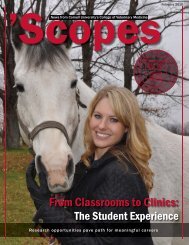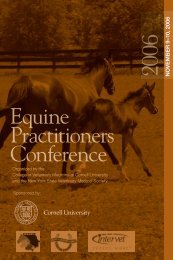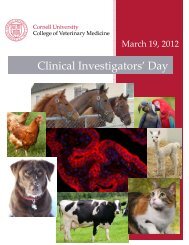2010 (PDF) - The College of Veterinary Medicine at Cornell University
2010 (PDF) - The College of Veterinary Medicine at Cornell University
2010 (PDF) - The College of Veterinary Medicine at Cornell University
Create successful ePaper yourself
Turn your PDF publications into a flip-book with our unique Google optimized e-Paper software.
Luise Steltzer, Freie Universität, Berlin, Transl<strong>at</strong>ional Science<br />
Wh<strong>at</strong>’s Bugging you? A culture independent approach to identifying antimicrobial<br />
resistance in clinical samples<br />
I started studying veterinary medicine with the intention to become a researcher.<br />
During vet school I discovered my particular interest in autoimmune diseases. I<br />
defi nitively want to pursue a PhD after my gradu<strong>at</strong>ion in 2011, but the Leadership<br />
Program aroused my interest in transl<strong>at</strong>ional science. Now I am thinking about<br />
doing an internship fi rst. <strong>The</strong> program was a gre<strong>at</strong> opportunity to meet brilliant<br />
people and to learn from them!<br />
Antibiotic resistance is an increasing problem in human and veterinary medicine.<br />
My research project in Kenneth Simpson´s lab focused on Clarithromycin<br />
resistance (ClaR) <strong>of</strong> gastric Helicobacter species in dogs. Using FISH analysis I<br />
identifi ed 4 out <strong>of</strong> 14 dogs in which the Clarithromycin therapy was unsuccessful.<br />
ClaR in H. pylori infected people is encoded by polymorphisms in 23S rRNA. My<br />
aim is to determine if 23S rRNA polymorphisms linked to ClaR in H.pyolri correl<strong>at</strong>e<br />
with outcome in dogs. I cloned and sequenced the peptidyl transferase region <strong>of</strong><br />
the 23 S rRNA gene <strong>of</strong> a variety <strong>of</strong> different Helicobacter spp to enable compar<strong>at</strong>ive<br />
analysis with H. pylori and 23SrRNA sequences amplifi ed from the stomach <strong>of</strong> dogs th<strong>at</strong> did and did not respond to<br />
Clarithromycin. Using Helicobacter species specifi c PCR I also hope to determine if there are differences between<br />
Helicobacter spp. regarding ClaR.<br />
I would like to thank my mentor Kenny Simpson and the members <strong>of</strong> his lab for their support. I also want to thank<br />
Drs. McGregor and Fraser for giving me the opportunity to particip<strong>at</strong>e in the program and Pfi zer for funding my<br />
scholarship.<br />
Frances Taylor-Brown, <strong>The</strong> Royal <strong>Veterinary</strong> <strong>College</strong>, Molecular Biology<br />
<strong>The</strong> Role and Regul<strong>at</strong>ion <strong>of</strong> Cancer Cell-Derived Microvesicles<br />
I have thoroughly enjoyed the <strong>Cornell</strong> Leadership Program, especially working<br />
in the lab and developing my critical thinking and scientifi c skills. Moreover the<br />
various workshops have given me the opportunity to explore different career<br />
options available as a veterinary gradu<strong>at</strong>e. At this stage I aim to pursue a career in<br />
academia where I could combine research and clinical work.<br />
Cancer cells demonstr<strong>at</strong>e unique characteristics including chemoresistance,<br />
enhanced growth and the ability to be locally invasive and metastasise.<br />
Microvesicles (MV’s) are membrane bound structures produced by cancer cells<br />
th<strong>at</strong> play an important role in tumour progression. In this project I studied the<br />
regul<strong>at</strong>ion and functions <strong>of</strong> MV’s using a range <strong>of</strong> techniques and have shown th<strong>at</strong><br />
MV’s derived from the human breast cancer cell line MDAMB231 are capable <strong>of</strong><br />
conferring transformed characteristics to normal human mammary cells MCF10A.<br />
I established th<strong>at</strong> there is a link between the altered metabolism <strong>of</strong> cancer cells<br />
and MV production; inhibition <strong>of</strong> glutaminase diminished MV production in both<br />
MDAMB231 and human glioblastoma U87 cells. Doxorubicin, a commonly used<br />
chemotherapeutic had no effect on MV production suggesting th<strong>at</strong> the action <strong>of</strong> doxorubicin is independent <strong>of</strong> the<br />
p<strong>at</strong>hway involved in MV production.<br />
I would like to express my sincere thanks to the Cerione labor<strong>at</strong>ory especially to Dr. Marc Antonyak and Pr<strong>of</strong>essor<br />
Richard Cerione for providing excellent support, guidance and encouragement throughout this project. In addition<br />
I would like to thank Drs. McGregor and Fraser for organising such a well structured and inspiring program, and<br />
express thanks to the Wellcome Trust who sponsored my time <strong>at</strong> <strong>Cornell</strong>.<br />
To prepare tomorrow’s scientists and public health pr<strong>of</strong>essionals<br />
33








